Customizing SAS
This page shows how you can customize your version of SAS 8.2 for Windows.
How do I set up a different WORK directory for SAS?
Sometimes, the default location for SAS temporary WORK directory may not be large enough. You can change the location for WORK directory when you start up SAS.
The easiest way to do it may be to modify the parameters for sas.exe. Here is how to do it.
Step 1. Right click on the icon of SAS and choose Properties. This will bring up a window called SAS Properties shown below.
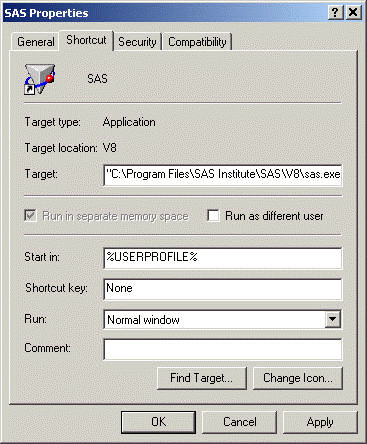
Step 2. Choose the Shortcut Menu.
The Target field tells us where the sas.exe is located and what parameters it takes. In this example, it looks like:
“C:Program FilesSAS InstituteSASV8sas.exe” -CONFIG “C:Program FilesSAS InstituteSASV8SASV8.CFG”
This tells us that the executable sas.exe is located in the folder C:Program FilesSAS InstituteSASV8 and it uses the default configuration file SASV8.CFG located in the folder C:Program FilesSAS InstituteSASV8.
Step 3. Let’s say that we want to change the WORK directory to D:temp. In the Target field, we can add “-work “D:temp” at the end. Then the target line becomes
“C:Program FilesSAS InstituteSASV8sas.exe” -CONFIG “C:Program FilesSAS InstituteSASV8SASV8.CFG” -work “D:temp”
Click on the OK button.
That’s all to it. Now after you fire up SAS, you can double check if the WORK directory has been set up to the location you want. For example, you can do:
proc options option=work; run;
(From Log Window:) 3 proc options option=work; 4 run;
SAS (r) Proprietary Software Release 8.2 TS2M0
WORK=D:temp_TD3260
Location for WORK SAS data library
You may notice that SAS actually created a subfolder in the directory that we have specified. This is because SAS allows multiple sessions (that is to say that you can fire up SAS multiple times) and each session will require its own temporary work space. SAS will create a unique temporary WORK directory for each of the multiple sessions in D:temp.
How do I display numbers along the left side of the Program Editor Window?
Some people prefer to have line numbers along the program as shown below.
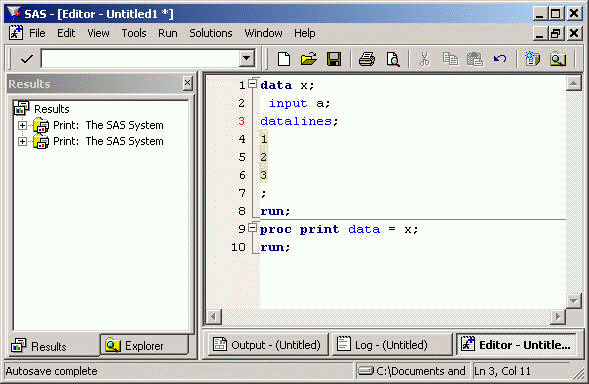
This can be done as follows. Notice that the Enhanced Editor Window (usually it is the Editor Window) has to be in focus in order to see the its options in the following steps.
Tools Options Enhanced Editor Options Choose Show line numbers
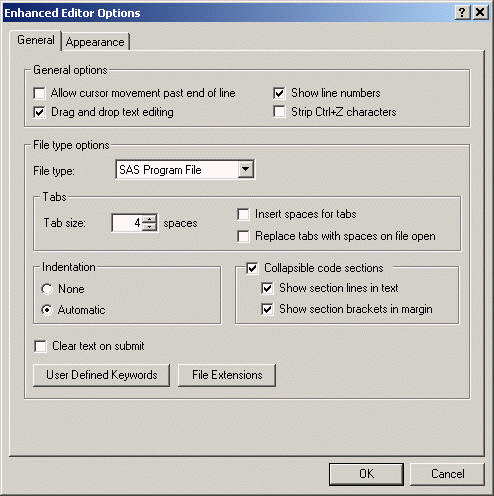
How do I change the appearance of my program editor window?
After starting SAS, click on the Editor Window so it is on focus. You can customize almost every aspect of the Editor Window, such as the color and font for comments, etc. You can save your choice as a customized scheme.
Tools Options Enhanced Editor Options Appearance
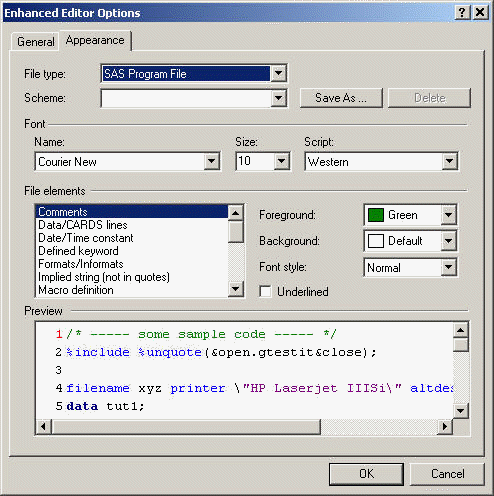
How do I create a webpage for the output from a procedure?
Sometimes, it may be desirable to create a webpage directly from the output from a procedure. For example, we have run a regression analysis and have also requested a plot as shown below. How do we put the output of the regression analysis and the plot together in one webpage?
proc reg data = hsb2; model write = math female; plot pred.*math = female; run; quit;
This can be down easily by allowing SAS to create an HTML page automatically. You may want to consider to turn the option on ONLY when you want to create a webpage based on the output.
Tools Options Preferences and then the Results tab Check Create HTML. You can view the results in the SAS internal browser (by default). If you wish, you can choose Preferred web browser and it will fire up a new web browser each time you submit a program and generate results.
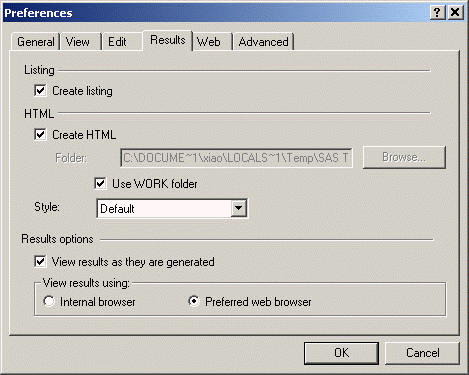
Here is the link to the page that SAS created based on the output from the code above.
How do I know the Function Key Commands?
There are many pre-defined keys in SAS to be used other than via point-and-click fashion. Most common one may be F3 key to run a SAS program in a Program Window that is on focus. The commonly used keys are:
| Key | Definition |
| F1 | SAS System Help |
| F3 | Submit |
| F5 | Editor Window |
| F6 | Log Window |
| F7 | Output Window |
| F8 | Zoom off; submit |
| F9 | Show definition of keys |
For example, by hitting F9 key, you will see a window like the one below:
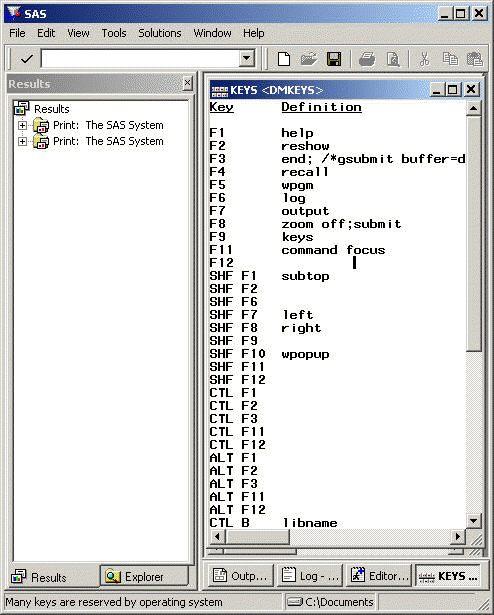
References
Glimore, Jodie, Painless Windows: A handbook for SAS users, Second Edition, Cary, NC: SAS Institute Inc., 1999
